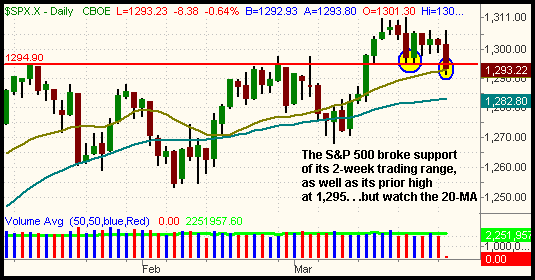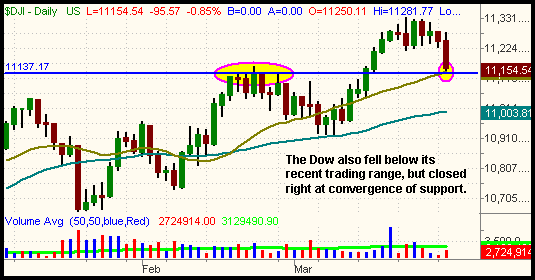Another quarter-point rate hike and hints of further rate increases from the Feds triggered a broad-based selloff that caused the S&P 500 and other indices to fall below support of their recent trading ranges yesterday afternoon. Stocks initially rallied ahead of the 2:15 pm FOMC announcement on interest rates, but reversed sharply immediately thereafter. The Dow Jones Industrial Average, which has been leading the broad market lately, gave back an intraday gain of 0.3% and closed 0.9% lower. The S&P 500 fell 0.6%, the Nasdaq Composite 0.5%, the small-cap Russell 2000 Index 0.4%, and the S&P Midcap 400 0.3%.
Turnover surged higher across the board yesterday, causing both the S&P and Nasdaq to register bearish "distribution days." Total volume in the NYSE increased by 13%, while volume in the Nasdaq was 7% higher than the previous day's level. The broad-based losses on higher volume indicates that institutions were aggressively selling in the late afternoon. It was the fourth such day of institutional selling within the past four weeks, which helps to explain why many breakouts to new highs have had trouble holding up.
We have not discussed our open ETF positions lately because the market has been in such a narrow and choppy range. However, yesterday's action finally caused some decent movement in our short positions. EWZ (iShares Brazil), which we have been short since March 21, plummeted 4.7% yesterday and broke support of its "neckline." As you may recall, we originally shorted EWZ as it was forming the right shoulder of a bearish "head and shoulders" chart pattern. Because it has closed below the "neckline" and on higher volume, we now expect EWZ to follow through towards its downward target in the $33 area. The daily chart of EWZ below illustrates this:

IGW (iShares Semiconductor), which we shorted on March 16 due to relative weakness in the Semiconductor Index, also made a nice downward move of 1.8%. Unfortunately, morning strength caused our short position in IWM (Russell 2000 Index) to stop out by only two cents before subsequently dropping later in the afternoon. However, we promptly notified subscribers that we shorted SPY (S&P 500) when it broke support of its trading range.
Although yesterday's action probably did not please the average retail investor, it was definitely a positive for short-term traders. Whether positioned on the long or short side of the market lately, I am certain that many traders have been looking forward to a break out of the broad market's choppy, sideways trading range. Short-term traders can profit equally from both uptrends and downtrends, but stagnant, range-bound markets always present a challenge to even the most skilled professionals. Because the S&P 500 broke support of its two-week trading range and its prior highs, there is a good chance we will finally see some follow-through of a trend for more than one day. But then again, we thought the same thing after the S&P's bearish reversal on March 21. The daily chart of the S&P 500 below illustrates the break of support:

As you can see, the S&P 500 closed right at its 20-day moving average. This level may try to provide support to the index, but a lot of new overhead supply has been created as well. Obviously, a break below the 20-day moving average would increase the odds of downward momentum increasing. Curiously, the Dow Jones Industrial Average also broke support of its trading range and closed right at its 20-day MA:

It will be interesting to see if we get follow-through on yesterday's bearish reversal because all recent attempts at both breakouts and sell-offs in the major indices have failed. However, it is probable that the Fed announcement provided the market with the impetus to break out of its volatility contraction. If we see further losses in the broad market, we are already well-positioned. But we certainly do not recommend being complacent on the short side given the market's recent track record of erratic behavior. Honor those stops regardless of whether you are long or short. Remember you can always re-enter a position after it has confirmed its direction. Re-entries in positions you stopped out of are often very profitable.
Deron Wagner is the Founder and Head Trader of both Morpheus Capital LP, a U.S. hedge fund, and Morpheus Trading Group, a trader education firm launched in 2001 that provides daily technical analysis of the leading ETFs and stocks. For a free trial to the full version of The Wagner Daily or to learn about Wagner's other services, visit MorpheusTrading.com or send an e-mail to deron@morpheustrading.com.